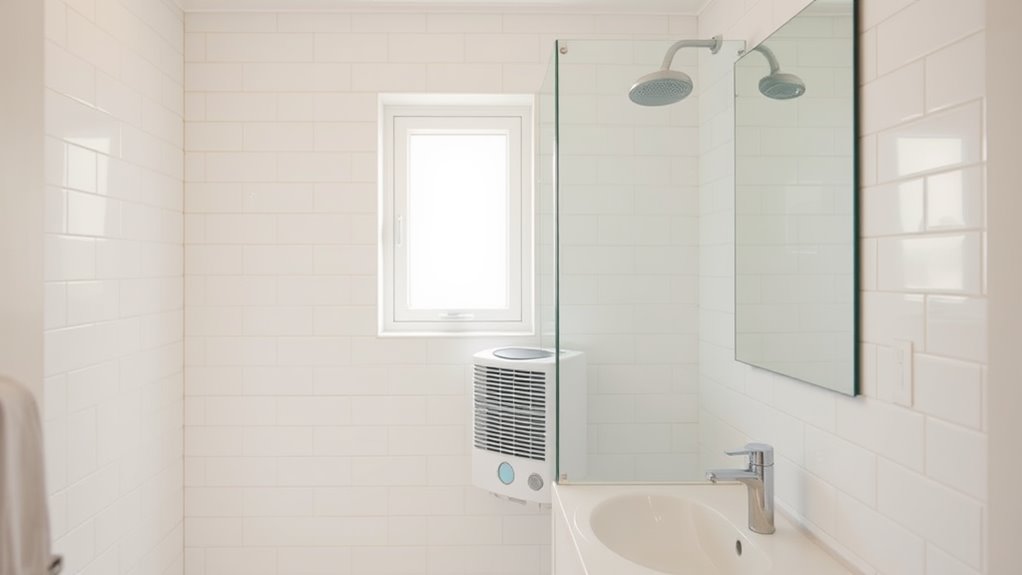Mold Control- Keep Your Bathroom Mold-Free With This Tip
Hey, if you’re battling bathroom mold, you’ve likely noticed those pesky black spots creeping along grout or walls. Don’t ignore them—mold thrives in damp, poorly ventilated spaces, posing health risks. There’s one simple, effective trick to stop it in its tracks, and it’s all about timing. Stick with me to uncover this game-changing habit that’ll keep your bathroom fresh and safe.
Key Takeaways
- Run an exhaust fan for 20 minutes after showers to reduce humidity.
- Wipe down tiles and walls daily to remove moisture buildup.
- Use a vinegar-water solution to clean mold-prone areas naturally.
- Fix leaks promptly to prevent water seepage and mold growth.
- Install mold-resistant paint or sealants on bathroom surfaces.
Understanding Bathroom Mold Risks
Why does bathroom mold seem to creep up so often? You’ve likely noticed those sneaky black spots in corners or on grout.
Bathrooms are damp, warm havens for mold spores, thriving on moisture from showers and poor air circulation. If you don’t tackle humidity, you’re inviting growth.
For effective bathroom mold prevention, keep things dry.
Wipe down surfaces after showers, use a squeegee on tiles, and fix leaks pronto.
Ensure your exhaust fan works well to vent steam.
Don’t let water pool; act fast.
These simple steps help you stop mold before it takes hold in your space.
Additionally, maintaining a consistent cleaning routine can significantly reduce moisture buildup and prevent mold growth.
Identifying Common Mold-Prone Areas
Having tackled the basics of bathroom mold risks, let’s zero in on where this pesky problem often hides.
Check around your shower and bathtub first—tiles, grout, and corners trap moisture, making them prime spots for mold.
Don’t overlook the sink area; water splashes and damp cloths can breed growth underneath.
Inspect window sills if you’ve got one, as condensation often collects there.
Lastly, scan walls near plumbing fixtures for discoloration or musty smells, signaling hidden leaks.
Using a daily anti-mold spray can help prevent growth in these high-risk areas.
Stay vigilant and catch these trouble zones early to keep your bathroom mold-free with minimal effort.
Essential Ventilation Strategies
Since bathroom mold thrives in damp, stagnant air, ensuring proper ventilation is your first line of defense.
Open windows after showers to let fresh air circulate and reduce humidity.
If your bathroom has an exhaust fan, turn it on during and for at least 20 minutes after bathing to pull moist air out.
Make sure the fan vents outside, not into the attic or walls, to avoid hidden mold growth.
If there’s no fan, consider installing one with a humidity sensor for automatic operation.
Check vents regularly for blockages to maintain effective airflow and keep mold at bay.
Incorporating a daily habit of wiping down wet surfaces can also significantly prevent mold growth.
Effective Cleaning Routines
To keep bathroom mold at bay, start by wiping down surfaces like countertops and shower walls daily with a dry or damp cloth to remove moisture and prevent spore buildup.
Make sure you open a window or run the exhaust fan after every shower to reduce humidity and dry out the space quickly.
Don’t forget to schedule a thorough deep cleaning at least once a month, scrubbing tiles, grout, and corners with a mold-fighting cleaner to tackle any hidden growth.
For an effective natural solution, try using vinegar as a mold-fighting cleaner to safely eliminate mold from bathroom surfaces.
Daily Surface Wiping
Often, the simplest way to prevent bathroom mold is by incorporating daily surface wiping into your routine.
Grab a microfiber cloth or disinfectant wipe and spend just a few minutes each day cleaning key areas.
Focus on countertops, sinks, and shower walls where moisture lingers. Wipe down faucet handles and any spots prone to splashes.
Use a mild cleaner if needed, ensuring you dry surfaces thoroughly to stop mold spores from taking hold.
Ventilation After Showers
After stepping out of a steamy shower, make sure you’ve got proper ventilation to combat bathroom mold.
Open a window if you’ve got one, letting fresh air circulate and reduce humidity.
If there’s no window, turn on the exhaust fan right after showering and leave it running for at least 20-30 minutes.
This pulls moist air out, preventing mold spores from settling on surfaces.
Check that your fan’s vent isn’t blocked and actually leads outside, not just into the attic.
Good airflow’s crucial, so don’t skip this step—it’s a simple way to keep mold at bay.
Regular Deep Cleaning
Routinely set aside time for a thorough bathroom deep clean to stop mold in its tracks.
Focus on areas prone to moisture, like grout, corners, and under the sink.
Use a scrub brush with a mold-killing cleaner—vinegar or bleach solutions work well—and scrub tiles and seams vigorously.
Don’t skip the shower curtain or liner; wash ‘em monthly to prevent buildup.
Dry every surface after cleaning to avoid dampness.
Schedule this deep clean bi-weekly, and you’ll keep mold spores from taking hold.
Consistency’s key, so stick to this routine for a spotless, mold-free bathroom.
Managing Humidity Levels
To manage humidity levels in your bathroom and prevent mold, start by monitoring air moisture with a hygrometer to keep it below 50%.
Make sure you’re running ventilation fans during and after showers for at least 20 minutes to whisk away excess dampness.
Don’t ignore leaky pipes—fix them promptly to stop water from seeping into walls and raising humidity.
Additionally, consider using a dehumidifier in the bathroom to maintain a cleaner and healthier space by reducing moisture buildup.
Monitor Air Moisture
How can you keep bathroom mold at bay when humidity levels spike?
Start by monitoring air moisture with a hygrometer, a handy tool to measure humidity.
Place it in your bathroom to track levels daily.
Ideally, keep humidity below 50% to discourage mold growth.
If you notice readings creeping higher, act quickly.
Use moisture-absorbing products like silica gel packs or dehumidifying crystals in small spaces.
Open windows to let fresh air circulate when it’s dry outside.
Use Ventilation Fans
Several effective ways exist to manage bathroom humidity, and using ventilation fans is a key strategy. After every shower, turn on the fan to pull moist air out and keep mold at bay. Make sure it’s running for at least 20 minutes to clear the steam. If your fan’s weak, consider upgrading to a stronger model with a higher CFM rating for better air exchange.
Check out this quick guide for fan use:
| Scenario | Fan Duration | Tip |
|---|---|---|
| Quick Shower | 15-20 mins | Open a window too! |
| Long Hot Bath | 30 mins | Keep door closed. |
| High Humidity Day | 25-30 mins | Check for mold spots. |
Fix Leaky Pipes
Tackle bathroom humidity by inspecting your pipes for leaks, as even small drips can spike moisture levels and invite mold growth.
Don’t ignore damp spots or musty smells under sinks or around fixtures; they’re warning signs.
Grab a wrench and check connections yourself, or call a plumber for bigger issues.
Here’s how to stay proactive:
- Regularly tighten loose fittings to prevent slow leaks.
- Inspect pipe joints for corrosion or wear, replacing parts as needed.
- Use a dry cloth to wipe pipes and catch early drips.
Fixing leaks fast keeps humidity down and mold at bay. Act now!
Choosing Mold-Resistant Materials
Picking the right materials can make a huge difference in keeping bathroom mold at bay.
Opt for mold-resistant drywall, often labeled as green board or cement board, when renovating your space. These resist moisture far better than standard drywall.
Choose porcelain or ceramic tiles for floors and walls; they’re non-porous and easy to clean.
Use mold-resistant paint with mildew inhibitors for a protective layer on walls.
Don’t skimp on grout—select epoxy-based options that repel water.
Lastly, install glass shower doors instead of curtains, as they won’t harbor dampness and are simpler to maintain.
Additionally, consider using natural pantry staples like vinegar or baking soda to clean surfaces and prevent mold growth naturally.
Quick Fixes for Minor Mold Issues
After focusing on mold-resistant materials to prevent issues, let’s address how you can handle small mold problems that still pop up.
Don’t let tiny mold spots grow; tackle them immediately with simple, effective solutions right at home.
Try these quick fixes to banish minor mold:
- Vinegar Solution: Mix equal parts white vinegar and water, spray on moldy spots, let it sit for 30 minutes, then scrub with a brush.
- Baking Soda Paste: Combine baking soda with water, apply to mold, scrub, and rinse.
- Hydrogen Peroxide: Dab 3% solution on mold, wait 10 minutes, scrub off.
Additionally, white vinegar is a powerful natural mold remedy that can help maintain a mold-free environment with regular use.
Long-Term Prevention Tips
While quick fixes can handle minor mold issues, you’ll want to focus on strategies that stop mold from coming back in the first place.
Start by improving ventilation—use an exhaust fan during and after showers, and crack a window if possible.
Next, fix leaks promptly; even small drips can fuel mold growth.
Keep surfaces dry by wiping down walls and tiles after use.
Invest in a dehumidifier if humidity lingers.
Finally, apply mold-resistant paint or sealants to vulnerable areas.
For an additional layer of protection, use a water-repellent spray on shower surfaces to prevent soap scum buildup before it starts.
These steps, done consistently, will help you maintain a mold-free bathroom for the long haul.

